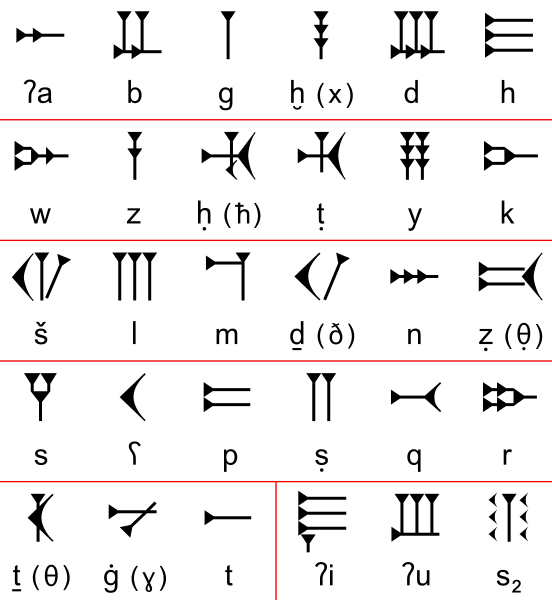Fitxer:Ugaritic-alphabet-chart.svg

Mida d'aquesta previsualització PNG del fitxer SVG: 552 × 600 píxels. Altres resolucions: 221 × 240 píxels | 442 × 480 píxels | 707 × 768 píxels | 942 × 1.024 píxels | 1.884 × 2.048 píxels | 622 × 676 píxels.
Fitxer original (fitxer SVG, nominalment 622 × 676 píxels, mida del fitxer: 28 Ko)
Historial del fitxer
Cliqueu una data/hora per veure el fitxer tal com era aleshores.
| Data/hora | Miniatura | Dimensions | Usuari/a | Comentari | |
|---|---|---|---|---|---|
| actual | 16:23, 13 març 2012 |  | 622 × 676 (28 Ko) | AnonMoos | tweaking crossbar of ħ |
| 03:13, 9 març 2012 |  | 622 × 676 (28 Ko) | AnonMoos | Table of letters of the Ugaritic cuneiform alphabet, with a conventional transcription. Where the "Semitological" symbols are somewhat divergent from the IPA symbol for the letter's probable pronunciation, the I... |
Ús del fitxer
Les 3 pàgines següents utilitzen aquest fitxer:
Ús global del fitxer
Utilització d'aquest fitxer en altres wikis:
- Utilització a af.wikipedia.org
- Utilització a am.wikipedia.org
- Utilització a ar.wikipedia.org
- Utilització a ast.wikipedia.org
- Utilització a be.wikipedia.org
- Utilització a bg.wikipedia.org
- Utilització a de.wikipedia.org
- Utilització a el.wikipedia.org
- Utilització a en.wikipedia.org
- Utilització a en.wiktionary.org
- Utilització a eo.wikipedia.org
- Utilització a es.wikipedia.org
- Utilització a fa.wikipedia.org
- Utilització a fr.wikipedia.org
- Utilització a gl.wikipedia.org
- Utilització a got.wikipedia.org
- Utilització a he.wikipedia.org
- Utilització a id.wikipedia.org
- Utilització a it.wikipedia.org
- Utilització a ja.wikipedia.org
- Utilització a kk.wikipedia.org
- Utilització a ko.wikipedia.org
- Utilització a lfn.wikipedia.org
- Utilització a ml.wikipedia.org
- Utilització a nl.wikipedia.org
- Utilització a no.wikipedia.org
- Utilització a pl.wikipedia.org
- Utilització a ru.wikipedia.org
- Utilització a rw.wikipedia.org
- Utilització a sl.wikipedia.org
- Utilització a sr.wikipedia.org
- Utilització a sv.wikipedia.org
- Utilització a th.wikipedia.org
- Utilització a uk.wikipedia.org
- Utilització a uz.wikipedia.org
- Utilització a zh.wikipedia.org

